-
Countries
-
Data and Analysis
-
Special Focus
-
Crisis Responses
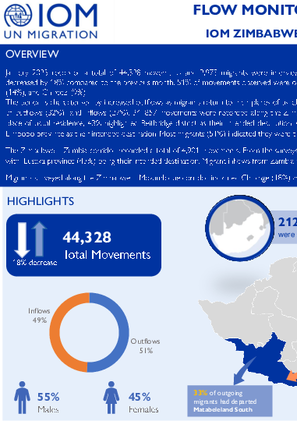
Contact
DTM Zimbabwe, DTMzimbabwe@iom.int, DTMsupport@iom.int
Language
English
Location
Zimbabwe
Period Covered
Jan 01 2023
Jan 31 2023
Activity
- Flow Monitoring
January 2023 recorded a total of 44,328 movements and 2,973 migrants were interviewed across 33 Flow Monitoring Points (FMPs) in Zimbabwe. The total movements recorded decreased by 18% compared to the previous month. 51% of movements observed were outflows, whilst 49% were inflows. The top three sending districts were Beitbridge (38%), Harare (14%), and Chiredzi (9%).
The period is characterised by increased outflows as migrants return to their places of usual residence after the December festive season. Matabeleland South recorded the highest number of outflows (32%) and inflows (27%). 34, 857 movements were recorded along the Zimbabwe-South Africa corridor. Of the migrants surveyed who indicated that Limpopo was their place of usual residence, 43% highlighted Beitbridge district as their intended destination. Outgoing migrants who had departed from Matabeleland South highlighted Vhembe district in Limpopo province as their intended destination. Most migrants (51%) indicated they were travelling to Vhembe district to conduct commercial activities.
The Zimbabwe – Zambia corridor recorded a total of 4,901 movements. From the surveys, conducted migrants indicated that they were travelling mainly to conduct commercial activities with Lusaka province (43%) being their intended destination. Migrant inflows from Zambia highlighted Karoi (45%) as their intended destination. Migrants surveyed along the Zimbabwe – Mozambique corridor indicated Chipinge (18%) as their intended destination and were travelling to access services.
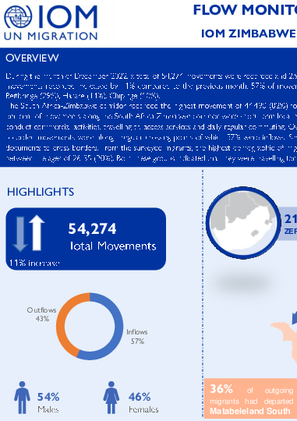
Contact
DTM Zimbabwe, DTMzimbabwe@iom.int, DTMsupport@iom.int
Language
English
Location
Zimbabwe
Period Covered
Dec 01 2022
Dec 31 2022
Activity
- Flow Monitoring
During the month of December 2022, a total of 54,274 movements were recorded and 2,922 migrants were interviewed across 33 Flow Monitoring Points (FMPs) in Zimbabwe. The total movements recorded increased by 11% compared to the previous month. 57% of movements observed were inflows, whilst 43% were outflows. The top three sending districts were Beitbridge (43%), Harare (13%), and Masvingo (6%).
The South Africa-Zimbabwe corridor recorded the highest movement of 44,490 (82%) followed by the Zambia-Zimbabwe corridor which recorded 5,625 (10%) movements. Thirty-six per cent of movements along the South Africa-Zimbabwe corridor were short-term local movements. These are characterised by movements of less than 6 months of people travelling to conduct commercial activities, travelling to access services and daily regular commuting. Overall, 37% of movements recorded during the period were family reunifications. 28,402 of the recorded movements were along irregular crossing points of which 57% were inflows. Sixty per cent of migrants who used irregular crossing points were in possession of identification documents to cross borders. From the surveyed migrant, the highest demographic of migrants using irregular crossing points were males between the ages of 36-45 (22%) and females between the ages of 26-35 (20%). Both these groups indicated that they were travelling for family reunifications and to conduct commercial activities.
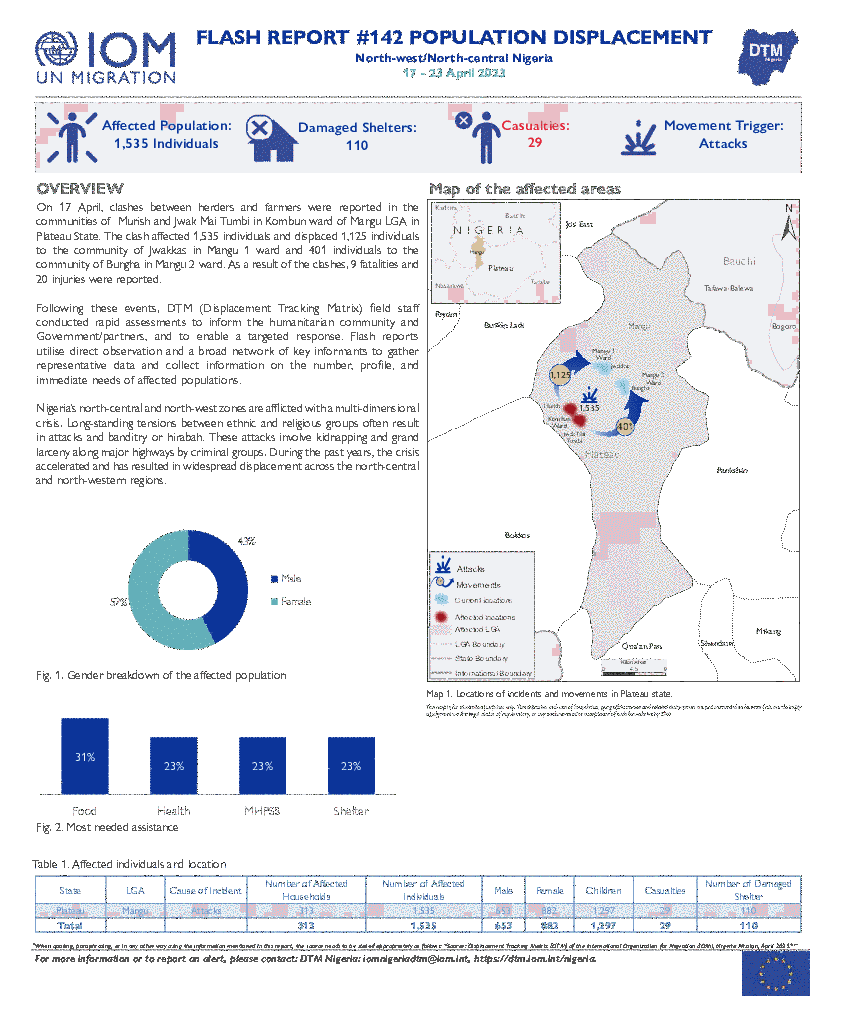
Contact
DTM Nigeria, iomnigeriadtm@iom.int
Language
English
Location
Nigeria
Period Covered
Apr 17 2023
Apr 23 2023
Activity
- Mobility Tracking
- Event Tracking
On 17 April, clashes between herders and farmers were reported in the communities of Murish and Jwak Mai Tumbi in Kombun ward of Mangu LGA in Plateau State. The clash affected 1,535 individuals and displaced 1,125 individuals to the community of Jwakkas in Mangu 1 ward and 401 individuals to the community of Bungha in Mangu 2 ward. As a result of the clashes, 9 fatalities and 20 injuries were reported.
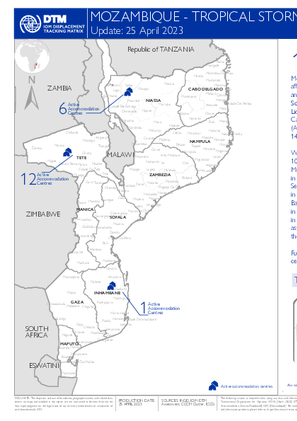
Contact
DTM Mozambique, DTMMozambique@iom.int
Language
English
Location
Mozambique
Period Covered
Feb 24 2023
Apr 25 2023
Activity
- Other
Mozambique’s National Institute for Disaster Management (INGD) estimates 1,187,265 individuals have been affected by the first and second landfall of Tropical Storm Freddy across Inhambane, Gaza, Zambezia, Sofala and Tete, Niassa and Manica provinces. As of 25 April 2023, rapid assessments across top-affected Postos in Sofala (Caia, Chemba, Chiramba, Cupanga, Marromeu, Mulima, Murraça, and Sena), Niassa (Cuamba, Insaca, Lione, Lunho, Mandimba) Tete (Charre, Doa, Inhangoma, and Nhamayabue), Manica (Amatongas, Bazua, Cafumpe, Gondola, Guro, Inchope, Mungari, Nguawala, Nhacafula, Nhacolo and Nhamagua) and Zambezia (Alto Molcue, Milange, Molumbo, Namacurra, Nante, and Nicoadala) report at least 542,770 individuals/ 143,207 families affected as well infrastructure damages to 177 schools, and 41 health centres.
Within these assessments 146,071 houses are reported as completely or partially destroyed. Approximately, 103,244 houses are located in Zambezia province (62,096 in Namacurra, 25,437 in Nicodala, 8,897 in Milange, 12 in Alto Molocue, and 6,802 in Nante postos), 29,789 houses are located in Sofala province (1,933 in Caia, 781 in Chemba, 42 in Chiramba, 2,145 in Chupanga, 1,070 in Marromeu, 89 in Mulima, 20,742 in Sena, and 2,987 in Murraça postos), 9,414 houses are located in Tete ( 2,202 in Doa, 6,899 in Inhagoma, 140 in Charre, and 173 in Nhamayabue Postos), 3,098 houses are located in Manica (729 in Nhamagua, 221 in Bazua, 498 in Guro, 712 in Mungari, 83 in Nhacafula, 140 in Amatongas, 97 in Cafumpe, 316 in Gondola, 93 in Inchope, 77 in Nguawala, and 132 in Nhacolo postos) and 370 houses are located in Niassa province (370 in Mandimba posto). The most cited priority needs in these most severely affected postos are for Agricultural
assistance/Food aid, closely followed by Shelter/NFIs . The priority need for WASH is slightly lower than for the previous two sectoral needs.
Furthermore, 37,967 individuals (11,750 families) remain displaced across 19 active accommodation centres/temporary displacement locations in Inhambane, Tete, and Niassa.

Contact
iomdrcdtm@iom.int
Language
French
Location
Democratic Republic of the Congo
Period Covered
Mar 30 2023
Apr 24 2023
Activity
- Mobility Tracking
- Event Tracking
Le 20 mars 2023, le site de déplacement Tchabi situé dans le village de Banzingi (Groupement de Baley, Chefferie de Banyali Tchabi, Zone de Santé de Boga) a été vidé de sa population suite à une réunion tenue le 27 février 2023 au bureau de la chefferie Tchabi. La réunion a regroupé les notables de la chefferie Banyali Tchabi, les officiers des forces mutualisées UPDF/FARDC et d'autres leaders communautaires de Boga, demandant à toutes les personnes déplacées du site de Tchabi de retourner dans leurs localités d'origine après l'enrôlement. Cette décision a conduit les personnes déplacées à détruire leurs tentes et à abandonner le site par crainte des conséquences si ces recommandations ne sont pas suivies. Certaines de ces personnes déplacées se sont réfugiées dans des familles d'accueil dans le village où se situe le site, tandis que d'autres se sont rendues dans le village de Malibongo dans le groupement Bukima, le village de Malaya dans le groupement Buley (chefferie Bahema Mitego), et les villages de Bandikide et Bwakadi respectivement dans les groupements Baley et Boyo (chefferie Banywali Tchabi).
Contact
DTMDRC@iom.int
Location
Democratic Republic of the Congo
Activity
- Mobility Tracking
- Baseline Assessment
Period Covered
Feb 20 2023 -Mar 15 2023
A baseline assessment is a sub-component of mobility tracking. It aims to collect data on IDP, migrant or returnee population presence in a defined administrative area of the country.
Population Groups
Survey Methodology
Unit of Analysis Or Observation
Type of Survey or Assessment
Keywords
Geographical Scope
Administrative boundaries with available data
The current dataset covers the following administrative boundaries

Contact
DTM Chad, dtmtchad@iom.int
Language
English
Location
Chad
Period Covered
Apr 11 2023
Apr 12 2023
Activity
- Mobility Tracking
- Event Tracking
Le 09 avril 2023, 15 ressortissants tchadiens (tous des adultes) ont été expulsés collectivement de la Libye et sont arrivés dans la ville d’Ounianga-Kébir le 10 avril 2023. La plupart des personnes expulsées sont originaires d’Abéché et de Batha. Ces derniers ont déclaré avoir été emprisonnés pendant deux à trois ans à Benghazi (Libye) avant d'être expulsés.
Ainsi, ces personnes expulsées n’ont reçu aucune assistance et vivent dans une situation de vulnérabilité critique (deux d’entre elles sont malades) et ne disposent d'aucun moyen pour poursuivre leur voyage vers leur communauté d'origine. De ce fait, elles ont manifesté avoir urgemment besoin de nourritures après avoir fait plusieurs jours sans manger, de soins de santé ainsi que d’assistance au transport vers leurs localités d’origine.
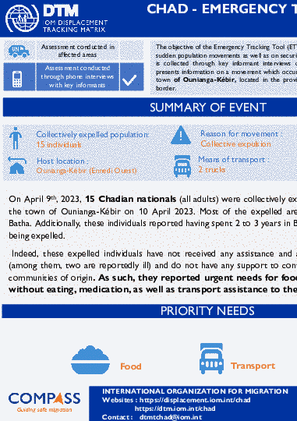
Contact
DTM Chad, dtmtchad@iom.int
Language
English
Location
Chad
Period Covered
Apr 11 2023
Apr 12 2023
Activity
- Mobility Tracking
- Event Tracking
On April 9th, 2023, 15 Chadian nationals (all adults) were collectively expelled to Libya and arrived in the town of Ounianga-Kébir on 10 April 2023. Most of the expelled are originally from Abéché and Batha. Additionally, these individuals reported having spent 2 to 3 years in Benghazi prison (Libya) before being expelled.
Indeed, these expelled individuals have not received any assistance and are living in a dire condition (among them, two are reportedly ill) and do not have any support to continue their trip towards their communities of origin. As such, they reported urgent needs for food after going several days without eating, medication, as well as transport assistance to their localities of origin.

Contact
Idiam Osorio, iosorio@iom.int
Language
English
Location
Panama
Period Covered
Jan 14 2023
Feb 14 2023
Activity
- Flow Monitoring Survey
- Flow Monitoring
La provincia del Darién se ubica en la frontera este de Panamá, y su territorio forma parte de las rutas migratorias más utilizadas por personas migrantes en movilidad por las Américas para migrar desde el sur hacia el norte del continente. A su vez, esta ruta es conocida por ser altamente peligrosa debido a las características geográficas de la selva y la presencia de crimen organizado. Las personas que la transitan se encuentran expuestas a riesgos varios como la trata de personas, tráfico ilícito, violencia basada en género, diversas formas de explotación y abuso. El uso de estas rutas inseguras para llegar a destinos temporarios o finales plantea amenazas para la integridad, dignidad y la vida misma.
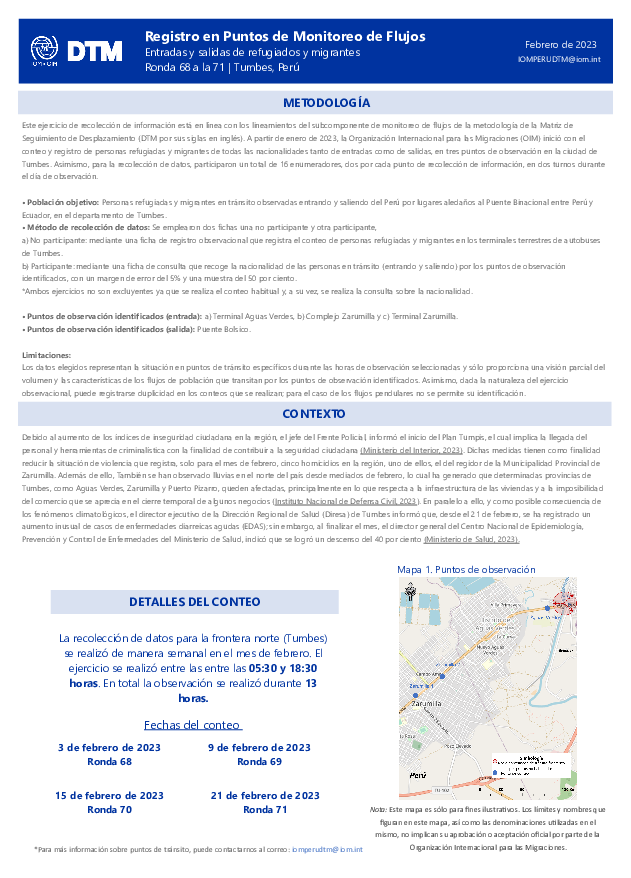
Contact
DTM Peru, IOMDTMPeru@iom.int
Language
English
Location
Peru
Period Covered
Feb 03 2023
Feb 21 2023
Activity
- Flow Monitoring
Debido al aumento de los índices de inseguridad ciudadana en la región, el jefe del Frente Policial, informó el inicio del Plan Tumpis, el cual implica la llegada del personal y herramientas de criminalística con la finalidad de contribuir a la seguridad ciudadana (Ministerio del Interior, 2023). Dichas medidas tienen como finalidad reducir la situación de violencia que se registra; solo para el mes de febrero, cinco homicidios en la región, uno de ellos, el del regidor de la Municipalidad Provincial de Zarumilla. Además de ello, También se han observado lluvias en el norte del país desde mediados de febrero, lo cual ha generado que determinadas provincias de Tumbes, como Aguas Verdes, Zarumilla y Puerto Pizarro, queden afectadas, principalmente en lo que respecta a la infraestructura de las viviendas y a la imposibilidad del comercio que se aprecia en el cierre temporal de algunos negocios (Instituto Nacional de Defensa Civil, 2023).